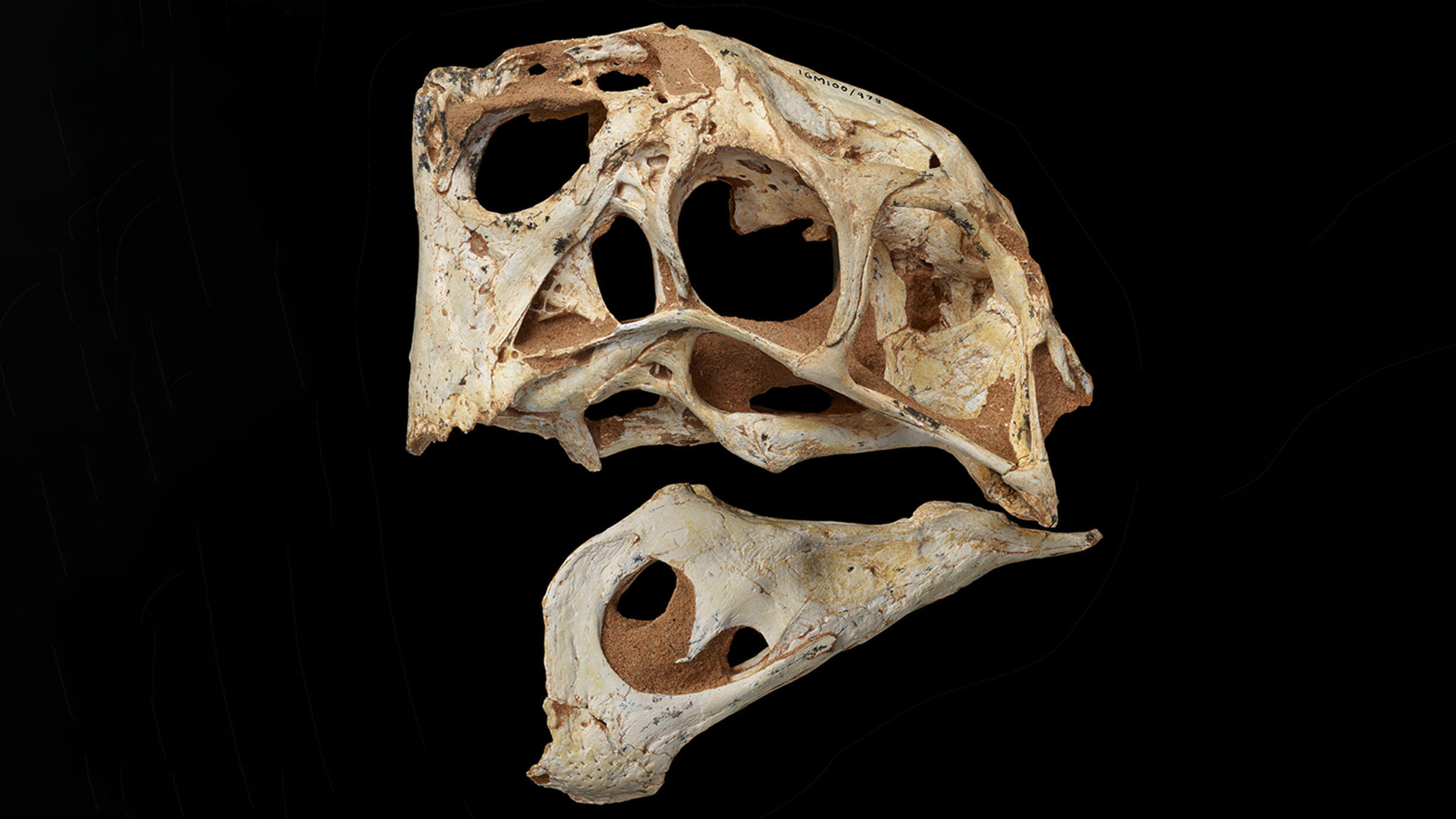AMNH Convenes Leading International Paleontologists for Two-Day Dinosaur Conference
 Fossil skull of Citipati osmolskae, collected in 1994 by the joint American Museum of Natural History/Mongolian Academy of Sciences team at Ukhaa Tolgod, Gobi Desert, Mongolia.
Fossil skull of Citipati osmolskae, collected in 1994 by the joint American Museum of Natural History/Mongolian Academy of Sciences team at Ukhaa Tolgod, Gobi Desert, Mongolia.Mick Ellison/© AMNH
Today, the American Museum of Natural History will bring together more than 30 leading paleontologists for a two-day conference, “Dinosaurs: New Discoveries,” in honor of noted paleontologist and Museum Curator Emeritus Mark Norell. Covering current research topics ranging from dinosaur brains and dinosaur flight to Scottish dinosaurs and Transylvanian dinosaurs, the convening brings together experts from around the country and world, all of whom have collaborated with, and in many cases were mentored by, Norell during his extraordinary 30-year career as curator of the Museum’s premier collection of fossil amphibians, reptiles, and birds.
“It’s hard to think of another paleontologist who has had anywhere near Mark’s impact on dinosaur science,” said Michael J. Novacek, a curator in the Museum’s Division of Paleontology and an organizer of the conference. “Mark’s work not only changed the field but also inspired a whole generation of young and brilliant scientific leaders.”
During his time at the Museum, Norell, who recently retired from the Museum’s Division in Paleontology and as a professor in the Richard Gilder Graduate School, and his collaborators have helped transform the field of paleontology, shifting it from a strictly geological focus—in which scientists primarily dig up, date, and describe a fossil—to a biological one. The new approach asks complex questions like “What did dinosaur brains looks like?”, “What color were their feathers?”, and “How did flight evolve?”
This conference will bring together many of the scientists who are exploring these questions at the Museum and across the world—traveling from China, Argentina, Germany, Scotland, Japan, and South Africa, among other countries. They will present research exploring topics including dinosaur growth and evolution, the origin of birds and feathers, mapping dinosaur brains, how artificial intelligence is being used in paleontology, and what sounds dinosaurs might have made.
During the conference, Norell officially received the Society of Vertebrate Paleontology’s Romer-Simpson Medal, the society’s highest award, which was accepted on his behalf at the society’s annual meeting in Cincinnati on October 21 and brought to New York.
In addition to Novacek, conference organizers include Suzann Goldberg (American Museum of Natural History), Julia Clarke (University of Texas at Austin), Peter Makovicky (University of Minnesota), Diego Pol (Museo Argentino de Ciencias Naturales), and Alan Turner (Stony Brook University).
Denis Finnin/© AMNH
For nearly three decades, Norell has been one of the team leaders of the joint American Museum of Natural History/Mongolian Academy of Sciences expeditions to the Gobi Desert. With the discovery of extraordinarily well-preserved fossils in Mongolia, Norell and the team generated new ideas about bird origins and the groups of dinosaurs to which modern birds are most closely related. Norell was also among the Mongolian American Expedition team members who discovered Ukhaa Tolgod, a significant fossil site, in 1993. Among the discoveries made there are the first embryo of a meat-eating dinosaur, the theropod dinosaurs Shuvuuia, Tsaagan, Khaan, and nesting Citipati sitting on top of their eggs in brooding positions.
In addition to field work in the Gobi, Patagonia, the Chilean Andes, the Carpathian mountains of Romania, and the Sahara, Norell was part of the team that in 1998 announced the discovery in northeastern China of two 120-million-year-old dinosaur species, both of which show unequivocal evidence of true feathers. He has named new dinosaurs, including Kol, Shanag, and Almas, and developed new ways of looking at fossils using CT scans and imaging. Norell served as curator on more than 10 major exhibitions, including T. Rex: The Ultimate Predator, Dinosaurs Among Us, Pterosaurs: Flight in the Age of Dinosaurs, The World’s Largest Dinosaurs, and Traveling the Silk Road. His online Seminars on Science graduate course “The Link Between Dinosaurs and Birds” has been taken by hundreds of teachers across the world, and an updated online course “Dinosaurs: Evolution, Extinction, and Paleobiology,” has already enrolled 29 teachers since its launch in the summer. He continues to work on the evolutionary relationships of dinosaurs and modern birds.
The Museum has a long and venerable history of international paleontological research and exploration. Museum paleontologists study the history of life on Earth through the discovery, analysis, and description of fossil remains of dinosaurs and other reptiles, mammals, birds, fishes, and invertebrates. The Division of Paleontology traces its history to the Museum’s Department of Vertebrate Paleontology, founded in 1891. Early expeditions carried out by Museum scientists include Barnum Brown’s expeditions to the American West (1900–1910), which resulted in the discovery of Tyrannosaurus rex, and Roy Chapman Andrews’ Central Asiatic Expeditions (1921–1930), which revealed a treasure trove of fossils in the Gobi Desert of Mongolia and in China, including the first scientifically recognized discovery of nests containing dinosaur eggs in 1923.
The Museum’s paleontology collection currently contains an estimated 5.56 million specimens, including more than 5 million fossil invertebrates and approximately 500,000 fossil vertebrates—one of the largest and most diverse collections of its kind in the world.